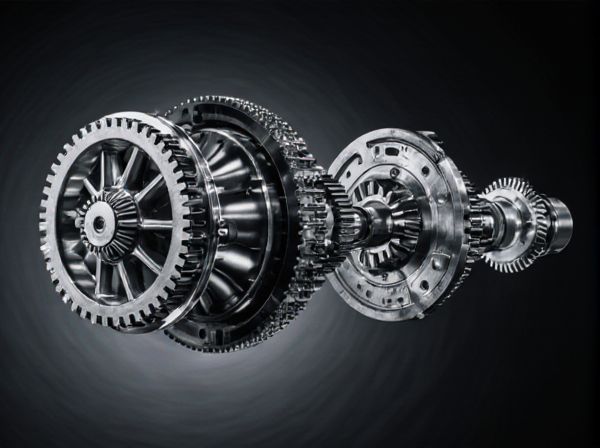
Photo illustration: Planetary Gear Transmission vs Parallel Shaft Transmission
Planetary gear transmission offers compact design, higher torque density, and superior load distribution compared to parallel shaft transmission. You benefit from smoother operation and increased efficiency in applications requiring high power and variable speed ratios. Parallel shaft transmission, however, is simpler to maintain and well-suited for moderate loads with straightforward mechanical layouts.
Table of Comparison
| Feature | Planetary Gear Transmission | Parallel Shaft Transmission |
|---|---|---|
| Gear Arrangement | Central sun gear with planet gears rotating around it | Multiple gears aligned on parallel shafts |
| Size & Compactness | Compact, space-efficient design | Relatively larger, less compact |
| Torque Capacity | High torque handling due to load distribution | Moderate torque capacity |
| Efficiency | High mechanical efficiency | Good efficiency but slightly lower than planetary |
| Application | Automatic transmissions, heavy machinery | Manual transmissions, simple gearboxes |
| Complexity | More complex design and manufacturing | Simple and easier to manufacture |
| Maintenance | Requires specialized maintenance | Relatively easier maintenance |
| Cost | Higher initial cost due to complexity | Lower cost, budget-friendly |
Introduction to Gear Transmission Systems
Gear transmission systems play a crucial role in mechanical power transfer, with planetary gear transmissions offering compact design, high torque density, and multiple gear ratios due to their unique sun, planet, and ring gear configuration. Parallel shaft transmissions feature gears mounted on parallel shafts, providing straightforward design, ease of maintenance, and efficient power transmission suitable for a wide range of industrial applications. Both systems optimize mechanical efficiency and durability but differ significantly in load distribution and spatial arrangement, influencing their suitability for specific engineering requirements.
Overview of Planetary Gear Transmission
Planetary gear transmission features a central sun gear, multiple planet gears, and a fixed ring gear, offering high torque density and compact design ideal for applications requiring efficient power distribution. This system provides high gear ratios within a small footprint, improving load distribution and reducing wear compared to parallel shaft transmissions. Commonly used in automatic transmissions, robotics, and heavy machinery, planetary gears excel in delivering smooth, reliable performance under varying load conditions.
Overview of Parallel Shaft Transmission
Parallel shaft transmissions consist of two or more shafts aligned parallel to each other, enabling the transfer of torque through meshing gears such as spur, helical, or bevel gears. These transmissions provide straightforward design and easy maintenance while offering high efficiency and smooth operation in a wide range of industrial applications. Commonly used in machinery requiring moderate torque and speed variations, parallel shaft gears excel in delivering reliable performance with balanced load distribution.
Key Structural Differences
Planetary gear transmission features a central sun gear, multiple planet gears revolving around it, and a stationary or rotating ring gear, enabling compact design and high torque density. Parallel shaft transmission consists of two or more gears aligned on parallel shafts, providing straightforward assembly and efficient power transfer between shafts. The planetary system offers coaxial arrangement and load distribution across multiple planets, whereas parallel shaft gears operate with simpler geometry and direct engagement between mating gears.
Efficiency Comparisons
Planetary gear transmissions typically exhibit higher efficiency than parallel shaft transmissions due to their compact design and multiple gear engagements distributing load evenly, minimizing energy losses. Efficiency ratings for planetary gear systems often range between 95% and 98%, whereas parallel shaft transmissions generally achieve 90% to 95%. The reduced friction and torque capacity in planetary gears result in better power transmission efficiency, especially under high load conditions.
Space and Weight Considerations
Planetary gear transmissions offer a more compact design and higher power density compared to parallel shaft transmissions, making them ideal for applications with strict space and weight constraints. Their coaxial arrangement distributes load across multiple gear meshes, which reduces component size and enhances torque capacity without increasing weight. Parallel shaft transmissions typically require larger housings and additional support bearings, resulting in greater space requirements and overall system weight.
Load Distribution and Torque Capacity
Planetary gear transmissions provide superior load distribution by distributing force across multiple planet gears around a central sun gear, enhancing torque capacity and durability under high-load conditions. In contrast, parallel shaft transmissions concentrate load on fewer gear teeth, which limits torque capacity and increases wear. The integrated design of planetary systems results in higher efficiency and consistent performance in heavy-duty applications compared to parallel shaft configurations.
Maintenance and Reliability
Planetary gear transmissions offer higher reliability due to their load distribution across multiple planets, reducing wear and maintenance frequency compared to parallel shaft transmissions, which experience uneven load distribution on gears. Maintenance for planetary gears is often less intensive, with sealed units requiring minimal lubrication changes, whereas parallel shaft transmissions demand more frequent inspections and gear oil replacements to prevent gear tooth wear and alignment issues. The compact design of planetary gear systems also contributes to lower maintenance downtime and enhanced operational lifespan in demanding industrial applications.
Typical Applications in Industry
Planetary gear transmissions are extensively used in compact, high-torque applications such as automotive automatic transmissions, industrial robotics, and wind turbine gearboxes due to their high power density and load distribution capabilities. Parallel shaft transmissions commonly appear in conveyors, machine tools, and printing presses where moderate torque and straightforward assembly are required, benefiting from easier maintenance and lower manufacturing costs. Industry selection depends on balancing torque requirements, space constraints, and mechanical complexity for optimal performance.
Choosing the Right Transmission System
Selecting the right transmission system depends on application requirements such as torque capacity, space constraints, and efficiency levels. Planetary gear transmissions offer compact size, high torque density, and balanced load distribution, making them ideal for heavy-duty and high-precision applications. Parallel shaft transmissions provide simpler design, ease of maintenance, and cost-effectiveness, suitable for moderate torque and straightforward mechanical setups.
 caratoz.com
caratoz.com